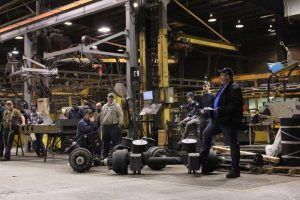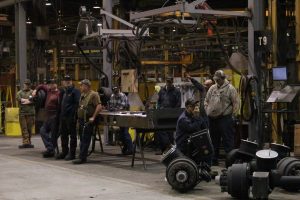Mark has discussed PPE and eye safety in the past, but today’s topic of discussion focused more on how to choose the proper eye gear for protection at work.

There are 2.4 million eye injuries annually in North America. With the use of eye protection, at least 90% of them could be prevented. With that said, Mark wanted to stress the difference between proper PPE and regular everyday prescription glasses. One major difference is that the frames and lenses of dress glasses do not undergo rigorous testing to ensure they can withstand stress and pressure without breaking. The last thing you want is glass or other objects in your eyes!

Adding side shields to prescription dress glasses may not be as safe as one suspects, also. In our experience, the added side shields often either do not fit properly or will not withstand any type of force or projectile hitting the glasses. Wearing prescription dress glasses with side shields in the workplace does not comply with OSHA requirements.
The wrong choice of glasses may not provide the protection you need based on your work, whether it is related to temperature, moisture, light or any other factor. For example, you could have poor vision wearing the glasses due to fog, scratches, reflection, bright lights, or even too much tint or shading.

With that said, here are some tips and information to remember when choosing your next pair of safety glasses:
- Lenses and frames must meet specific requirements to qualify as compliant OSHA safety eyewear.
- There are major distinctions between prescription safety glasses and prescription street glasses.
- Lens Testing: Lenses for high impact safety glasses must be tested and withstand impact from a 1/4” steel ball shot at 150 fps (feet per second). Lenses for prescription dress glasses only need to withstand impact from a 5/8” steel ball dropped from a height of 50 inches.
- The Plus: Lenses for safety glasses must be marked with the manufacturer’s monogram and a “+” mark to indicate they meet the High Impact testing standard. Prescription dress glasses do not require this marking as they are not tested for High Impact..
- Frame Testing: Safety frames are tested with 2.0mm polycarbonate to ensure they can withstand the impact from a 1/4” steel ball traveling at 150 fps without dislodging the lenses. Dress frames do not meet OSHA requirements. All parts of a safety frame are marked with Z87-2, indicating that they have been tested to withstand High Impact whereas dress frames do not require this marking.
- Side Shields: Safety frames have ANSI Z87 tested side shields for added protection whereas side shields are not made for prescription dress glasses. Dress frames with side shields do not meet ANSI standards for safety. All safety eyewear must be marked in specific ways in order to meet the ANSI Z87.1-2003 Standard.
Have a safe week everyone!





